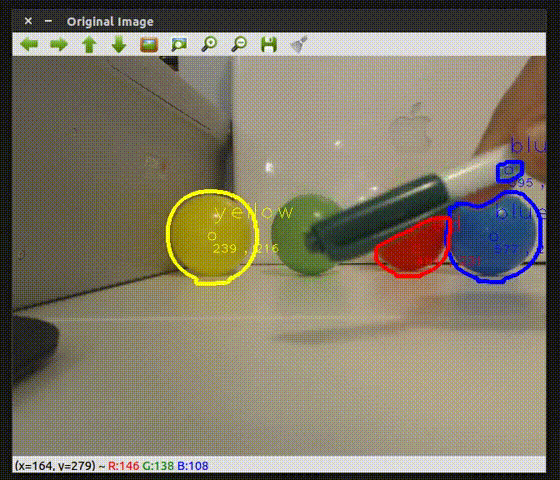看效果 下面源代码

Object.h
#pragma once
#include <string>
#include <cv.h>
#include <highgui.h>
using namespace std;
using namespace cv;
class Object
{
public:
Object();
~Object(void);
Object(string name);
int getXPos();
void setXPos(int x);
int getYPos();
void setYPos(int y);
Scalar getHSVmin();
Scalar getHSVmax();
void setHSVmin(Scalar min);
void setHSVmax(Scalar max);
string getType(){return type;}
void setType(string t){type = t;}
Scalar getColor(){
return Color;
}
void setColor(Scalar c){
Color = c;
}
private:
int xPos, yPos;
string type;
Scalar HSVmin, HSVmax;
Scalar Color;
};
Object.cpp
#include "Object.h"
Object::Object()
{
//为默认构造函数设置值
setType("Object");
setColor(Scalar(0,0,0));
}
Object::Object(string name){
setType(name);
if(name=="blue"){
//TODO:使用“校准模式”查找HSV最小值和最大值
setHSVmin(Scalar(92,0,0));
setHSVmax(Scalar(124,256,256));
//BGR value for Blue:
setColor(Scalar(255,0,0));
}
if(name=="green"){
//TODO:使用“校准模式”查找HSV最小值和最大值
setHSVmin(Scalar(34,50,50));
setHSVmax(Scalar(80,220,200));
//绿色的BGR值:
setColor(Scalar(0,255,0));
}
if(name=="yellow"){
//TODO:使用“校准模式”查找HSV最小值和HSV最大值
setHSVmin(Scalar(20,124,123));
setHSVmax(Scalar(30,256,256));
//黄色的BGR值:
setColor(Scalar(0,255,255));
}
if(name=="red"){
//TODO:使用“校准模式”查找HSV最小值和HSV最大值
setHSVmin(Scalar(0,200,0));
setHSVmax(Scalar(19,255,255));
//BGR value for Red:
setColor(Scalar(0,0,255));
}
}
Object::~Object(void)
{
}
int Object::getXPos(){
return Object::xPos;
}
void Object::setXPos(int x){
Object::xPos = x;
}
int Object::getYPos(){
return Object::yPos;
}
void Object::setYPos(int y){
Object::yPos = y;
}
Scalar Object::getHSVmin(){
return Object::HSVmin;
}
Scalar Object::getHSVmax(){
return Object::HSVmax;
}
void Object::setHSVmin(Scalar min){
Object::HSVmin = min;
}
void Object::setHSVmax(Scalar max){
Object::HSVmax = max;
}
multipleObjectTracking.cpp
#include <sstream>
#include <string>
#include <iostream>
#include <vector>
#include "Object.h"
//初始最小和最大HSV过滤器值。
//更改轨迹栏
int H_MIN = 0;
int H_MAX = 256;
int S_MIN = 0;
int S_MAX = 256;
int V_MIN = 0;
int V_MAX = 256;
//默认capture 宽度和高度
const int FRAME_WIDTH = 640;
const int FRAME_HEIGHT = 480;
//帧中要检测的最大对象数
const int MAX_NUM_OBJECTS=50;
//最小和最大物体面积
const int MIN_OBJECT_AREA = 20*20;
const int MAX_OBJECT_AREA = FRAME_HEIGHT*FRAME_WIDTH/1.5;
//每个窗口顶部的名称
const string windowName = "Original Image";
const string windowName1 = "HSV Image";
const string windowName2 = "Thresholded Image";
const string windowName3 = "After Morphological Operations";
const string trackbarWindowName = "Trackbars";
//下面是canny边缘检测的示例:
Mat dst, detected_edges;
Mat src, src_gray;
int edgeThresh = 1;
int lowThreshold;
int const max_lowThreshold = 100;
int ratio = 3;
int kernel_size = 3;
const char* window_name = "Edge Map";
void on_trackbar( int, void* )
{//每当发生错误时,就调用此函数
}
string intToString(int number){
std::stringstream ss;
ss << number;
return ss.str();
}
void createTrackbars(){
//创建窗口轨迹栏
//下面注释有些写英文了 方便理解 ( 输入法切换太麻烦)
namedWindow(trackbarWindowName,0);
//create memory to store trackbar name on window
char TrackbarName[50];
sprintf( TrackbarName, "H_MIN", H_MIN);
sprintf( TrackbarName, "H_MAX", H_MAX);
sprintf( TrackbarName, "S_MIN", S_MIN);
sprintf( TrackbarName, "S_MAX", S_MAX);
sprintf( TrackbarName, "V_MIN", V_MIN);
sprintf( TrackbarName, "V_MAX", V_MAX);
//创建轨迹栏并将其插入窗口
//3个参数为:移动轨迹栏时发生变化的变量地址(如H_LOW),
//轨迹栏可以移动的最大值(例如H_高),
//以及每当移动轨迹栏时调用的函数(例如,在轨迹栏上)
// ----> ----> ---->
createTrackbar( "H_MIN", trackbarWindowName, &H_MIN, H_MAX, on_trackbar );
createTrackbar( "H_MAX", trackbarWindowName, &H_MAX, H_MAX, on_trackbar );
createTrackbar( "S_MIN", trackbarWindowName, &S_MIN, S_MAX, on_trackbar );
createTrackbar( "S_MAX", trackbarWindowName, &S_MAX, S_MAX, on_trackbar );
createTrackbar( "V_MIN", trackbarWindowName, &V_MIN, V_MAX, on_trackbar );
createTrackbar( "V_MAX", trackbarWindowName, &V_MAX, V_MAX, on_trackbar );
}
void drawObject(vector<Object> theObjects,Mat &frame, Mat &temp, vector< vector<Point> > contours, vector<Vec4i> hierarchy){
for(int i =0; i<theObjects.size(); i++){
cv::drawContours(frame,contours,i,theObjects.at(i).getColor(),3,8,hierarchy);
cv::circle(frame,cv::Point(theObjects.at(i).getXPos(),theObjects.at(i).getYPos()),5,theObjects.at(i).getColor());
cv::putText(frame,intToString(theObjects.at(i).getXPos())+ " , " + intToString(theObjects.at(i).getYPos()),cv::Point(theObjects.at(i).getXPos(),theObjects.at(i).getYPos()+20),1,1,theObjects.at(i).getColor());
cv::putText(frame,theObjects.at(i).getType(),cv::Point(theObjects.at(i).getXPos(),theObjects.at(i).getYPos()-20),1,2,theObjects.at(i).getColor());
}
}
void drawObject(vector<Object> theObjects,Mat &frame){
for(int i =0; i<theObjects.size(); i++){
cv::circle(frame,cv::Point(theObjects.at(i).getXPos(),theObjects.at(i).getYPos()),10,cv::Scalar(0,0,255));
cv::putText(frame,intToString(theObjects.at(i).getXPos())+ " , " + intToString(theObjects.at(i).getYPos()),cv::Point(theObjects.at(i).getXPos(),theObjects.at(i).getYPos()+20),1,1,Scalar(0,255,0));
cv::putText(frame,theObjects.at(i).getType(),cv::Point(theObjects.at(i).getXPos(),theObjects.at(i).getYPos()-30),1,2,theObjects.at(i).getColor());
}
}
void morphOps(Mat &thresh){
//创建用于“扩张”和“侵蚀”形象的结构元素。
//the element chosen here is a 3px by 3px rectangle
Mat erodeElement = getStructuringElement( MORPH_RECT,Size(3,3));
//dilate with larger element so make sure object is nicely visible
Mat dilateElement = getStructuringElement( MORPH_RECT,Size(8,8));
erode(thresh,thresh,erodeElement);
erode(thresh,thresh,erodeElement);
dilate(thresh,thresh,dilateElement);
dilate(thresh,thresh,dilateElement);
}
void trackFilteredObject(Mat threshold,Mat HSV, Mat &cameraFeed)
{
vector <Object> objects;
Mat temp;
threshold.copyTo(temp);
//these two vectors needed for output of findContours
vector< vector<Point> > contours;
vector<Vec4i> hierarchy;
//find contours of filtered image using openCV findContours function
findContours(temp,contours,hierarchy,CV_RETR_CCOMP,CV_CHAIN_APPROX_SIMPLE );
//use moments method to find our filtered object
double refArea = 0;
bool objectFound = false;
if (hierarchy.size() > 0) {
int numObjects = hierarchy.size();
//if number of objects greater than MAX_NUM_OBJECTS we have a noisy filter
if(numObjects<MAX_NUM_OBJECTS)
{
for (int index = 0; index >= 0; index = hierarchy[index][0])
{
Moments moment = moments((cv::Mat)contours[index]);
double area = moment.m00;
//如果面积小于20px乘以20px,则可能只是噪声
//如果面积与图像大小的3/2相同,可能只是一个坏的过滤器
//只需要具有最大面积的对象,因此每个对象都有一个安全的参考区域
//迭代并将其与下一次迭代中的区域进行比较。
if(area>MIN_OBJECT_AREA)
{
Object object;
object.setXPos(moment.m10/area);
object.setYPos(moment.m01/area);
objects.push_back(object);
objectFound = true;
}
else objectFound = false;
}
//let user know you found an object
if(objectFound ==true)
{
//draw object location on screen
drawObject(objects,cameraFeed);
}
}
else putText(cameraFeed,"TOO MUCH NOISE! ADJUST FILTER",Point(0,50),1,2,Scalar(0,0,255),2);
}
}
void trackFilteredObject(Object theObject,Mat threshold,Mat HSV, Mat &cameraFeed){
vector <Object> objects;
Mat temp;
threshold.copyTo(temp);
//这两个向量是FindContentours输出所需的
vector< vector<Point> > contours;
vector<Vec4i> hierarchy;
//使用openCV findContours函数查找过滤图像的轮廓
findContours(temp,contours,hierarchy,CV_RETR_CCOMP,CV_CHAIN_APPROX_SIMPLE );
//使用矩方法查找过滤对象
double refArea = 0;
bool objectFound = false;
if (hierarchy.size() > 0) {
int numObjects = hierarchy.size();
//if number of objects greater than MAX_NUM_OBJECTS we have a noisy filter
if(numObjects<MAX_NUM_OBJECTS){
for (int index = 0; index >= 0; index = hierarchy[index][0]) {
Moments moment = moments((cv::Mat)contours[index]);
double area = moment.m00;
//如果面积小于20px乘以20px,则可能只是噪声
//如果面积与图像大小的3/2相同,可能只是一个坏的过滤器
//只需要具有最大面积的对象,因此每个对象都有一个安全的参考区域
//迭代并将其与下一次迭代中的区域进行比较。
if(area>MIN_OBJECT_AREA){
Object object;
object.setXPos(moment.m10/area);
object.setYPos(moment.m01/area);
object.setType(theObject.getType());
object.setColor(theObject.getColor());
objects.push_back(object);
objectFound = true;
}else objectFound = false;
}
//找到了一个对象
if(objectFound ==true){
//draw object location on screen
drawObject(objects,cameraFeed,temp,contours,hierarchy);}
}else putText(cameraFeed,"TOO MUCH NOISE! ADJUST FILTER",Point(0,50),1,2,Scalar(0,0,255),2);
}
}
int main(int argc, char* argv[])
{
//如果要校准过滤器值,请设置为true。
bool calibrationMode = true;
//Matrix to store each frame of the webcam feed
Mat cameraFeed;
Mat threshold;
Mat HSV;
if(calibrationMode){
//create slider bars for HSV filtering
createTrackbars();
}
//用于获取网络摄像头提要的视频捕获对象
VideoCapture capture;
//open capture object at location zero (default location for webcam)
capture.open(0);
//set height and width of capture frame
capture.set(CV_CAP_PROP_FRAME_WIDTH,FRAME_WIDTH);
capture.set(CV_CAP_PROP_FRAME_HEIGHT,FRAME_HEIGHT);
//启动一个无限循环,将网络摄像头提要复制到cameraFeed矩阵
//all of our operations will be 在这个循环中执行
waitKey(1000);
while(1){
//store image to matrix
capture.read(cameraFeed);
src = cameraFeed;
if( !src.data )
{ return -1; }
//将帧从BGR转换为HSV颜色空间
cvtColor(cameraFeed,HSV,COLOR_BGR2HSV);
if(calibrationMode==true){
//需要找到合适的颜色范围值
// 校准模式必须为false
//如果处于校准模式,根据HSV滑块值跟踪对象。
cvtColor(cameraFeed,HSV,COLOR_BGR2HSV);
inRange(HSV,Scalar(H_MIN,S_MIN,V_MIN),Scalar(H_MAX,S_MAX,V_MAX),threshold);
morphOps(threshold);
imshow(windowName2,threshold);
//canny边缘检测的后续步骤
/// 创建一个与src(用于dst)类型和大小相同的矩阵
dst.create( src.size(), src.type() );
/// 图像转换为灰度
cvtColor( src, src_gray, CV_BGR2GRAY );
/// Create a window
namedWindow( window_name, CV_WINDOW_AUTOSIZE );
// 创建一个追踪栏供用户输入阈值
createTrackbar( "Min Threshold:", window_name, &lowThreshold, max_lowThreshold);
/// Show the image
trackFilteredObject(threshold,HSV,cameraFeed);
}
else{
//创建一些临时姐果对象,以便可以使用他们的成员功能/信息
Object blue("blue"), yellow("yellow"), red("red"), green("green");
//首先找到蓝色的物体
cvtColor(cameraFeed,HSV,COLOR_BGR2HSV);
inRange(HSV,blue.getHSVmin(),blue.getHSVmax(),threshold);
morphOps(threshold);
trackFilteredObject(blue,threshold,HSV,cameraFeed);
//then yellows
cvtColor(cameraFeed,HSV,COLOR_BGR2HSV);
inRange(HSV,yellow.getHSVmin(),yellow.getHSVmax(),threshold);
morphOps(threshold);
trackFilteredObject(yellow,threshold,HSV,cameraFeed);
//then reds
cvtColor(cameraFeed,HSV,COLOR_BGR2HSV);
inRange(HSV,red.getHSVmin(),red.getHSVmax(),threshold);
morphOps(threshold);
trackFilteredObject(red,threshold,HSV,cameraFeed);
//then greens
cvtColor(cameraFeed,HSV,COLOR_BGR2HSV);
inRange(HSV,green.getHSVmin(),green.getHSVmax(),threshold);
morphOps(threshold);
trackFilteredObject(green,threshold,HSV,cameraFeed);
}
//show frames
//imshow(windowName2,threshold);
imshow(windowName,cameraFeed);
//imshow(windowName1,HSV);
//延迟30毫秒,以便屏幕可以刷新。
//没有此waitKey()命令,图像将不会显示
waitKey(30);
}
return 0;
}
工程项目:
链接:https://pan.baidu.com/s/1BUnslDd-FK2WFeVeLYp5Yw
提取码:1rwn
工程文件虽然跑起来了但是可能有点问题 需要自行调试:目前我没有细调试
如果不清楚怎么配置 参考这个博客
https://blog.csdn.net/weixin_39276851/article/details/106720387
邮箱:okjokull@gmail.com
最后
以上就是仁爱龙猫最近收集整理的关于C++ opencv实现颜色识别的全部内容,更多相关C++内容请搜索靠谱客的其他文章。
本图文内容来源于网友提供,作为学习参考使用,或来自网络收集整理,版权属于原作者所有。








发表评论 取消回复